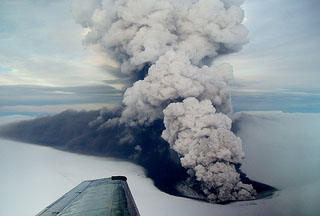Report on Grimsvotn (Iceland) — 1 December-7 December 2021
Smithsonian Institution / US Geological Survey
Weekly Volcanic Activity Report, 1 December-7 December 2021
Managing Editor: Sally Sennert.
Please cite this report as:
Global Volcanism Program, 2021. Report on Grimsvotn (Iceland) (Sennert, S, ed.). Weekly Volcanic Activity Report, 1 December-7 December 2021. Smithsonian Institution and US Geological Survey.
Grimsvotn
Iceland
64.416°N, 17.316°W; summit elev. 1719 m
All times are local (unless otherwise noted)
The Icelandic Meteorological Office (IMO) reported that the jökulhlaup (glacial outburst flood) due to subsidence of the ice shelf in Grímsvötn’s caldera continued until 6 December. Subsidence of the ice shelf into the underlying lake had begun around 24 November in an area SE of Grímsfjall. Water from the lake drained from the E side of Skeiðarárjökull and from a channel in the middle of a trail into the Gígjukvísl River, causing rising waters first detected in that river overnight during 30 November-1 December. By 2 December the flow rate in the river was 930 meters per second, triple what was detected three days before, and 10 times the normal seasonal rate. Daily measurements showed that the flow rate continued to rise, likely peaking at 2,800 meters per second during the morning of 5 December; a second measurement later that day showed a lower discharge rate of 2,310 meters per second. The ice shelf continued to subside, though more slowly, and water turbulence in the lake had also decreased; the data indicated that the lake was mostly empty of water. A number of detected earthquakes were attributed to subsiding and breaking ice.
By 6 December the ice shelf had subsided a total of about 77 m. At 0615 an M 2.3 earthquake was immediately followed by a M 3.6 one minute later. Five more earthquakes were recorded during 1500-2130, though all were below M 1. IMO raised the Aviation Color Code to Orange (the second highest level on a four-color scale) based on the increased seismicity during the previous few days, the larger events that morning, and considerations such as short run-up times seen before previous eruptions, and those past eruptions occasionally following flood events. Seismic tremor had decreased by the next day, and no signs of eruptive activity were indicated in gas or deformation data. On 7 December the Aviation Color Code was lowered to Yellow.
Geological Summary. Grímsvötn, Iceland's most frequently active volcano in recent history, lies largely beneath the vast Vatnajökull icecap. The caldera lake is covered by a 200-m-thick ice shelf, and only the southern rim of the 6 x 8 km caldera is exposed. The geothermal area in the caldera causes frequent jökulhlaups (glacier outburst floods) when melting raises the water level high enough to lift its ice dam. Long NE-SW-trending fissure systems extend from the central volcano. The most prominent of these is the noted Laki (Skaftar) fissure, which extends to the SW and produced the world's largest known historical lava flow in 1783. The 15 km3 basaltic Laki lavas were erupted over 7 months from a 27-km-long fissure system. Extensive crop damage and livestock losses caused a severe famine that resulted in the loss of one-fifth of the population of Iceland.

